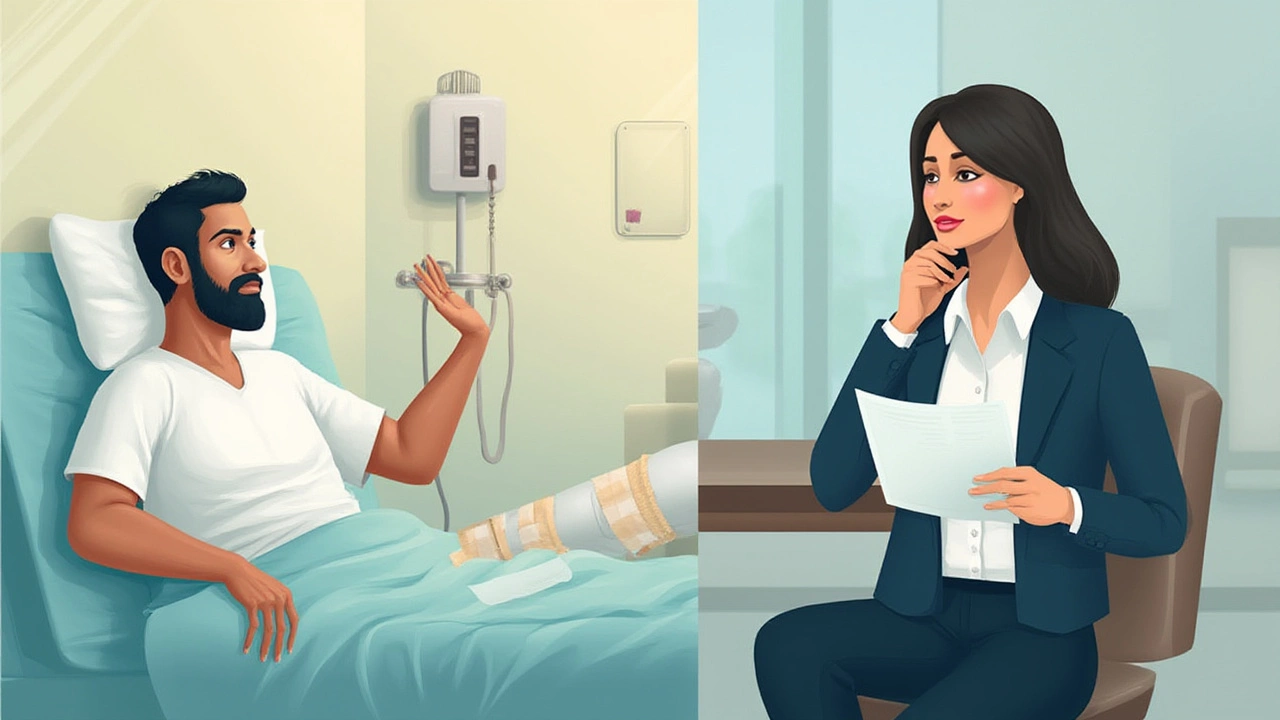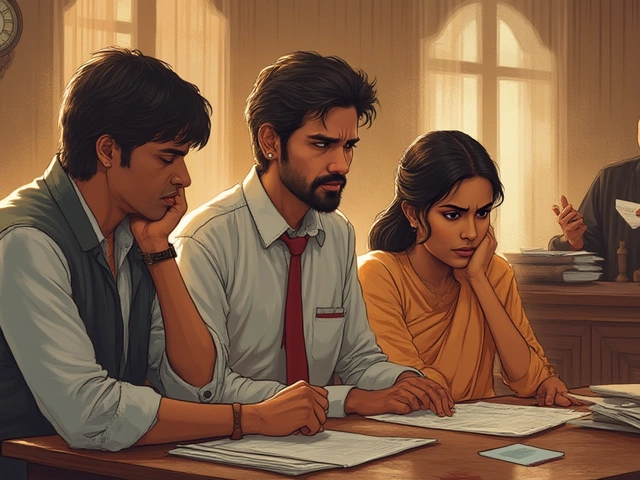Picture this: my son Aryan gets whacked in the nose during a local cricket match—the ball, a bit too friendly, lands squarely on his face. Now, Aryan’s nose is bleeding: there’s swelling, pain, maybe even a fracture. This is what anyone would call a physical injury—clear damage to the body, something you can see or an X-ray can prove. But if Aryan trips because the cricket pitch had a big, neglected pothole and I want to sue the club? Now, we’re tiptoeing into personal injury territory. One is medical, the other is legal. The difference isn’t just a matter of words—it can change whether you get an apology or an insurance payout large enough to cover medical bills, time off work, and maybe even Aryan’s new mouthguard collection.
Breaking Down Physical Injury: The Body Takes the Hit
So, what is physical injury? Simply put, this means any kind of harm that affects your body directly. Broken bones, cuts, bruises, burns, or snapped ligaments—all of these fall under physical injuries. You can touch them, see them, test for them. If the doctors can scribble it down in your file, it’s likely a physical injury. According to health care data in India, about 63% of emergency hospital visits are due to physical injuries—road accidents, household mishaps, and, yes, sports injuries like Aryan’s. But here’s a surprising fact: not every physical injury leads to a lawsuit or compensation. If Leela falls off her bicycle at home, it’s painful—and maybe it’s my fault for letting her bike inside—but legally, that’s just life. No one outside our family is liable.
The causes of physical injury are endless: car accidents, slipping in the bathroom, electrocution from faulty wires, or getting bitten by a neighbor’s dog. There’s an entire branch of medicine, called trauma care, that deals with just these injuries. Courts usually use medical reports, X-rays, and expert opinions to confirm whether a physical injury has actually happened. This is crucial for insurance—without that paperwork, your claim might as well be written on a napkin. Even minor injuries like a sprained wrist can count, but severe cases—head injuries, broken spines—are obviously treated more seriously. Healing time varies massively too; think of the difference between a paper cut (days) and a fractured femur (months or even years)!
One area people forget: physical injury isn’t always visible. Internal bleeding, whiplash, and even some types of organ damage aren’t obvious without a scan. In fact, a 2022 study from Mumbai hospitals found that nearly 40% of internal injuries aren’t spotted at first because patients just “feel a little sore.” So, physical injury isn’t just about what you can see. If it disrupts the way your body works, it’s still in this category.
Physical injury matters for doctors and insurance companies first. Hospitals decide your treatment and when you can leave. Health insurers check your X-rays and discharge summary—if the forms stack up, they approve your claim. Courts, however, go further. They want to know if someone else is responsible for your pain.
Personal Injury: Where the Law Steps In
If you want things to get complicated, step into the world of personal injury. Think of physical injury as the wound; personal injury is the court case or insurance claim that grows out of it. Personal injury happens when someone’s actions, or failure to act, cause harm to you and you want compensation. It’s about rights, fault, and, let’s be honest, money. For example, I take Aryan to a cricket club and the field isn’t maintained. He trips, gets hurt. Now I ask: Did the club fail to fix a danger they should have? Did someone act irresponsibly? If the answer is yes, Aryan’s physical injury becomes a personal one—at least in the eyes of the law.
Lawyers get busy once a personal injury comes into play. Now, the legal claim looks at ‘duty of care’—did someone have the responsibility to keep you safe? Was that responsibility broken? And did it directly lead to harm? There’s even a checklist for this, known as the “4 D’s”: Duty, Dereliction (breach), Damage, Direct cause. Miss any step, and your personal injury case could fall apart. This is why a major part of personal injury law is investigating the situation, collecting CCTV evidence, checking maintenance logs, and interviewing witnesses (yes, even grumpy old uncles at the ground).
Personal injury cases cover a wider field than most of us realize. Road accidents, workplace mishaps, dog bites, even emotional distress from accidents—these can all lead to claims. In India, personal injury claims have shot up: between 2019 and 2024, Mumbai saw over 27,000 new personal injury lawsuits, mostly tied to road traffic accidents and construction site falls (according to the Maharashtra Law Department). The essential difference: someone else is at fault. If Leela falls while biking in the community park, and there’s a hidden open drain with no cover, suddenly the park authority is in the legal spotlight.
The damages you can claim go beyond the wound. Personal injury includes lost wages, therapy costs, and, in some cases, emotional trauma—think nightmares, anxiety, or PTSD after a car crash. Courts in India rarely award massive amounts for pain and suffering, but they do factor it in. The bigger the harm and clearer the fault, the higher the compensation. Here’s a quick comparison table to sum this up:
| Aspect | Physical Injury | Personal Injury |
|---|---|---|
| Main Focus | Bodily harm or trauma | Legal claim for harm, including bodily or psychological |
| Proof Needed | Medical reports, test results | Duty, breach, causation, legal responsibility |
| Examples | Broken arm, cut, burn | Slip at a store, car accident due to negligence |
| Compensation | Medical insurance | Medical, wages, damages for pain, legal costs |
| Invisible Injuries | Possible (internal injuries) | Yes (emotional trauma too) |
| Must Prove Fault? | No | Yes |

The Legal Nuts and Bolts: Building a Solid Case
Here’s where things get technical. A physical injury by itself doesn’t guarantee a payout; you have to prove someone else’s carelessness led to your harm for it to become a personal injury case. Smart lawyers start by gathering rock-solid evidence. They grab medical records (sometimes even get doctors to testify), find out what safety rules applied, and hunt for violations. Photographs of the damaged road or injury, witness statements, police reports—these all help show the court exactly what happened.
Let’s not forget deadlines. Personal injury law in India has a “limitation period”—usually, you must file your case within three years of the injury. Miss it, and your claim is dead, no matter how clear the fault. The clock starts ticking the day you know (or should have known) the injury was due to someone else’s action. This is tricky with internal injuries or diseases that show up years later (for example, a construction worker who develops silicosis after years of dust exposure). Courts sometimes allow extra time, but you don’t want to count on that.
A solid claim also needs to show the impact of the injury. It’s not just about pain—it’s about days missed at work, therapy bills, and even the emotional toll. Take Aryan: if his broken nose puts him out of the finals, can I argue for compensation for “loss of opportunity”? Possibly, but I’ll need evidence—a coach’s note, tournament schedules, regular medical updates. A big tip: keep a diary. Any changes in daily life (can’t sleep, trouble eating, mood changes) could help your case. Courts like stories that make sense and have proof.
Another fact for those who think ‘settlement’ is some magic word: over 70% of personal injury cases settle before trial. Insurers and businesses often prefer this because it’s cheaper and less public. Both sides negotiate—sometimes for months—to agree on a number. But, and this matters, if you accept a settlement, you usually can’t sue for more money later. So, check everything carefully. Personal story here—I once sprained my ankle at an amusement park, skipped the claim, only to learn a year later I’d missed out on getting therapy costs covered. Lesson learned: talk to a lawyer before signing anything!
Tips for Navigating Injury Claims
If your injury is someone else’s fault, don’t freeze up. Here’s what works—from people who’ve been to court and back:
- See a doctor, no delays: Even if it seems minor. Injuries can get worse, and early reports look better to insurance and courts.
- Gather proof: Photos, videos, receipts, witness contacts—anything could be important later.
- Report it: Accidents in public (schools, parks, public transport) should be reported to the right authority immediately. Get a copy of the report.
- Keep good records: Save every prescription, test, bill, and leave record from work. Make a timeline of what happened.
- Don’t negotiate alone: Insurance companies and businesses usually have their own lawyers. Get legal advice before agreeing to settlements or signing papers.
- Be realistic about timelines: Injury cases can take months or even years to resolve, especially if there are surgeries or long-term effects.
- Understand compensation: You can claim for hard costs (bills, lost wages) and sometimes softer costs (pain, suffering). But you’ll need evidence for everything.
- Stay off social media: Posting about your injury can backfire. Insurers can use your posts against you, even smiling selfies on a bad day.
Insurance stats show less than 30% of injured people file personal injury claims, according to a 2023 survey by the Insurance Regulatory and Development Authority of India. Most don't realize their rights or think the process is too much trouble. Yet, if the injury is serious, the process can make sure your family doesn’t end up paying for someone else’s mistake.
The next time you hear “injury,” try to remember this: is it physical? Or is it personal too? Not all bruises are created equal in the eyes of the law—and your rights, your family’s peace of mind, and sometimes your bank balance depend on knowing the difference.


